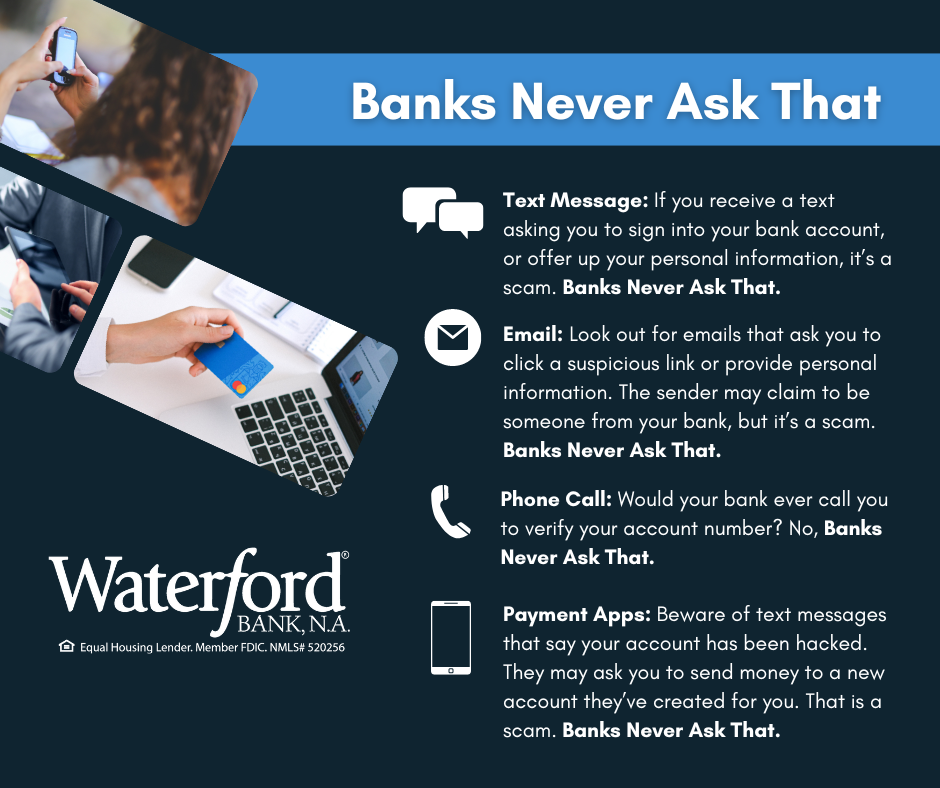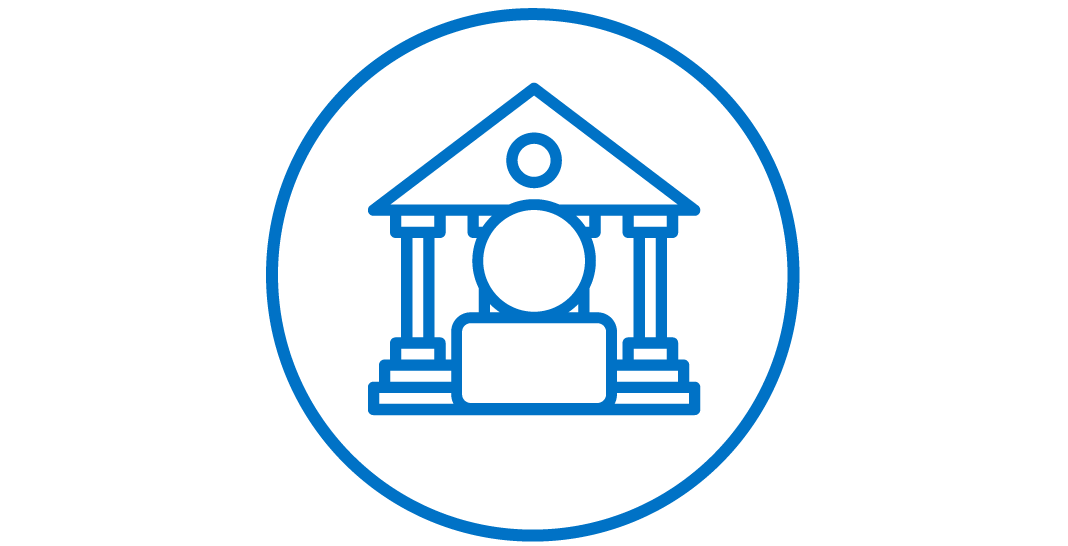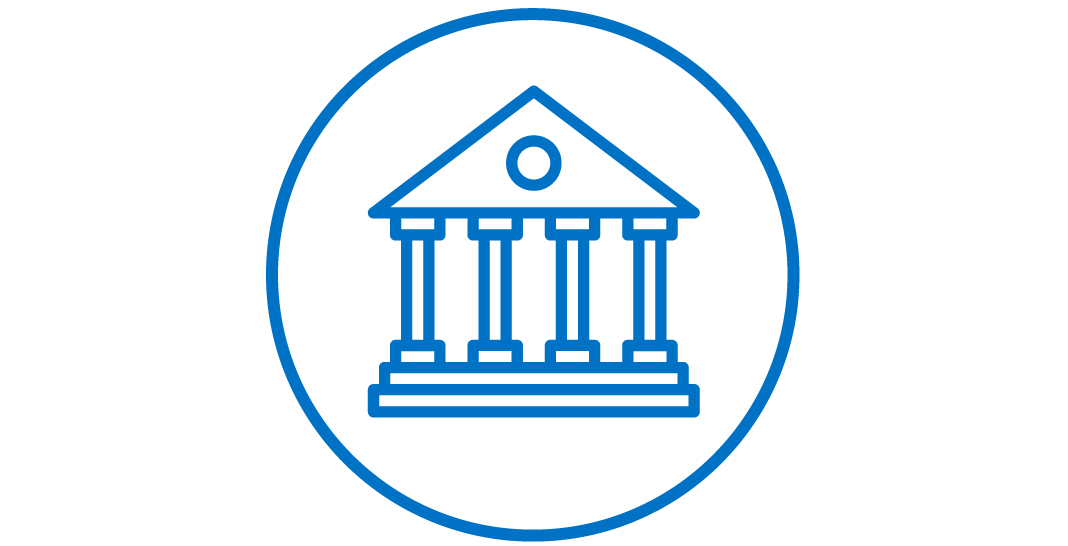Adam Mroz, Personal Banker
Every day, scammers trick thousands of people using fraudulent emails, text messages and phone calls that they claim are from the victim’s bank.
According to the Federal Trade Commission (FTC), Americans lost $5.8 billion to phishing scams and other fraudulent acts in 2021 – that’s an increase of more than 70% compared to 2020.
But when you know what to look out for, you can stop fraudsters in their tracks. In an effort to further protect your account, Waterford Bank is committed to helping you spot these scams.
It starts with four words: Banks Never Ask That.
What is Phishing?
A phishing scam is when a criminal sends fraudulent messages to someone that look like they come from a legitimate bank. People lose hundreds, and sometimes even thousands, of dollars every year to these scammers.

A scammer pretends to be with an organization you know, like your bank or doctor’s office. Once they have you fooled they trick you into handing over your sensitive information like passwords and account numbers.
The goal of phishing is to trick you into handing over confidential information, like your account number, a password or your birthday. They will often do this by sending you a link and asking you to enter your information into a fake website. Sometimes, they will call and imitate someone from your bank to try and convince you to tell them your information directly.
Phishing Red Flags, What to Look Out For
Here are some common examples of phishing scam attempts:

- Text Message: If you receive a text asking you to sign into your bank account, or offer up your personal information, it’s a scam. Banks Never Ask That.
- Email: Watch out for emails that ask you to click a suspicious link or provide personal information. The sender may claim to be someone from your bank, but it’s a scam. Banks Never Ask That.
- Phone Call: Would your bank ever call you to verify your account number? No, Banks Never Ask That. If you’re ever unsure if the caller is legitimate, just hang up and call the bank directly at a number you trust.
- Payment Apps: Beware of text messages from someone claiming to be your bank saying your account has been hacked. The scammer may ask you to send money to a new account they’ve created for you, but that’s a scam. Banks Never Ask That.
What to Do if You Suspect Phishing Fraud
If you receive text or email that you believe could be a scam, here’s what you should do.
First, don’t panic. According to the American Bankers Association, it’s usually fine to open a scam email or text. Most of the current email apps, like Gmail, are built to detect and block any code or malware from running when you open a message.
However, it is very important that you do not click any links or download attachments. Attachments may contain malware like viruses, worms or spyware and phishing links will take you to fraudulent websites.

When you receive a phishing communication, be sure that you do not click any links or attachments. These will more than likely download a virus to your device or take you to a fake website to try and steal your information.
Do not reply to the message. The American Bankers Association advises consumers to ignore any requests from the sender.
Finally, report it. You can forward suspected phishing emails to the Anti-Phishing Working Group at reportphishing@apwg.org or, if you received a phishing text message, send it to SPAM (7726). You can also file a report with the FTC at https://reportfraud.ftc.gov.
But, what happens if a phishing attempt is made by phone call?
If you receive a call that seems suspicious, hang up. The American Bankers Association warns that area codes can be misleading. Just because your Caller ID displays a local area code, it doesn’t always mean the call is being made from a local source.
Don’t respond to requests from the caller. Legitimate banks and other institutions won’t call you to request personal information.
What to Do if You Fall Victim to a Phishing Scam
If you’ve given out your personal or financial information and realize you may have been the victim of a scam, contact your bank right away by using its trusted customer service number. This information can usually be found on the back of your bank card.
Speak with the fraud department and explain what happened. Request to close or freeze accounts that may have been tampered with or fraudulently opened.

If you suspect you’ve fallen victim to a phishing scam, immediately change any passwords and PIN numbers that may have been targeted.
If you bank online, make sure to change your login credentials, passwords and PINs. Additionally, the American Bankers Association suggests changing your email or cell phone passwords and establishing multi-factor authentication. Many people repeat the same passwords and those accounts could be compromised as well.
Next, check your credit reports. You can get a copy from annualcreditreport.com or by calling 877-322-8228. Make sure no unauthorized accounts have been opened in your name. If you do spot fraudulent activity, report it to the appropriate institution.
You can also place a fraud alert on your credit by contacting one of the three credit bureaus. Once you inform one of them, that company must inform the other two. They include:
- Experian: 888-397-3742 or www.experian.com
- TransUnion: 800-680-7289 or www.transunion.com
- Equifax: 888-766-0008 or www.equifax.com
If a deposit account has been impacted, you can place a security alert on the compromised checking and savings account by calling ChexSystems at 888-478-6536.
Finally, file reports with both the FTC and your local law enforcement. You can get a copy of the police report to submit to creditors and other institutions that may require proof there was a crime. To contact the FTC, call 877-438-4338 or visit www.identitytheft.gov.
Stay in-the-know to Protect Your Information
The best way to protect yourself against phishing scams is to stay alert and informed. For tips, videos and an interactive game to help prepare you to fight against phishing, visit www.BanksNeverAskThat.com. For more local banking resources, check out our fraud resources below.
About the Author

Adam Mroz is a Personal Banker at Waterford Bank, N.A. in Toledo, Ohio. He has served the banking needs of families and businesses in Northwest Ohio for the last 6 years and prides himself on the connections he makes with his customers.
Out of the office, he enjoys working with the Bank to help build homes for neighbors in need through Habitat for Humanity, as well as cook meals for the families served by the Ronald McDonald House Charities of Toledo. Want to connect? Contact us here.


